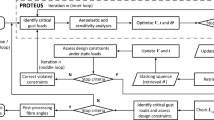Summary
Effects of aspect ratio, sweep angle, and stacking sequence of laminated composites were studied to find the optimized configuration of an aeroelastically tailored composite wing idealized as a flat plate in terms of flutter speed. The aeroelastic analysis has been carried out in the frequency domain. The modal approach in conjunction with doublet-lattice method (DLM) has been chosen for structural and unsteady aerodynamic analysis, respectively. The interpolation between aerodynamic boxes and structural nodes has been done using surface splines. To study the effect of stacking sequence the classical lamination theory (CLT) has been chosen. The parametric studies showed the effective ply orientation angle to be somewhere between 15 and 30 degrees, while the plates with lower aspect ratio seem to have higher flutter speeds. Forward-swept configurations show higher flutter speed, yet imposed by divergence constraints.
Similar content being viewed by others
References
Weisshaar T. A. (1981). Aeroelastic tailoring of forward swept composite wings. J. Aircraft 18: 669–676
Sherrer V. C., Hertz T. J. and Shirk M. H. (1981). Wind tunnel demonstration of aeroelastic tailoring applied to forward swept wings. J. Aircraft 18: 976–983
Shirk M. H., Hertz T. J. and Weisshaar T. A. (1986). Aeroelastic tailoring – theory, practice, and promise. J. Aircraft 23: 6–18
Rogers W. A., Braymen W. W. and Shirk M. H. (1983). Design, analyses, and model tests of an aeroelastically tailored lifting surfaces. J. Aircraft 20: 208–215
Hollowell S. J. and Dugundji J. (1984). Aeroelastic flutter and divergence of stiffness coupled, graphite/epoxy cantilevered plates. J. Aircraft 21: 69–76
Lin K.-J., Lu P.-J. and Tran J.-Q. (1989). Flutter analysis of cantilevered composite plates in subsonic flow. AIAA J. 27: 1102–1109
Isogai K. (1992). Transonic flutter/divergence characteristics of aeroelastically tailored and non-tailored high-aspect-ratio forward-swept wings. J. Fluid Struct. 6: 525–537
Kuttenkeuler J. and Ringertz U. (1998). Aeroelastic design and optimization with experimental verification. J. Aircraft 35: 505–507
Chattopadhyay A., Seeley C. E. and Jha R. (1999). Aeroelastic tailoring using piezoelectric actuation and hybrid optimization. Smart Matr. Struct. 8: 83–91
Qin Z., Marzocca P. and Librescu L. (2002). Aeroelastic instability and response of advanced aircraft wings at subsonic flight speeds. Aerosp. Sci. Technol. 6: 195–208
Kornecki A., Dowell E. H. and O’Brien J. (1976). On the aeroelastic instability of two-dimensional panels in uniform incompressible flow. J. Sound Vibr. 47: 163–178
Rodden, W. P., Johnson, E. H.: MSC.NASTRAN V68 Aeroelastic analysis user’s guide, Vol. 1
Hodges, D. H., Pierce, G. A.: Introduction to structural dynamics and aeroelasticity. Cambridge University Press 2002
Kaw, A. K.: Mechanics of composite materials. CRC Press 1997
Kolonay, R. M.: Computational aeroelasticity. RTA-NATO, The Applied Vehicle Technology Panel, General Electric Corporate Research & Development Center Ankara, Turkey, Oct. 1–5, 2001
Morozov, E. V.: Mechanics and analysis of fabric composites and structures. AUTEX Res. J. 4, (2004)
Albano E. and Rodden W. P. (1969). A doublet-lattice method for calculating lift distributions on oscillating surfaces in subsonic flows. AIAA J. 7: 279–285
Hedman, S. G.: Vortex lattice method for calculation of quasi steady state loadings on thin elastic wings. Aeronautical Research Institute of Sweden, Report No. 105 (1965)
Patil, M. J.: Nonlinear aeroelastic analysis, flight dynamics, and control of a complete aircraft. PhD thesis, Georgia Institute of Technology 1999
Author information
Authors and Affiliations
Corresponding author
Rights and permissions
About this article
Cite this article
Attaran, A., Majid, D.L., Basri, S. et al. Structural optimization of an aeroelastically tailored composite flat plate made of woven fiberglass/epoxy. Acta Mech 196, 161–173 (2008). https://doi.org/10.1007/s00707-007-0488-y
Received:
Accepted:
Published:
Issue Date:
DOI: https://doi.org/10.1007/s00707-007-0488-y




